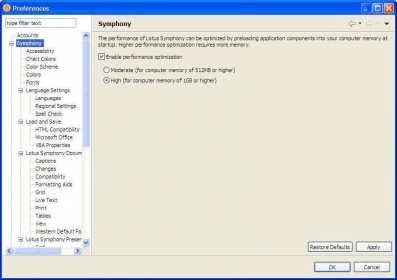After around eight months in beta, Lotus Symphony 3.0 has finally made it to a final release. This free alternative to Microsoft Office is based on the open-source OpenOffice, but throws in some useful features of its own to make it stand out from the crowd. These include support for VBA scripts to tempt professional users to switch to Symphony (and then pay for the cloud-based LotusLive collaboration services), plus plug-ins that enable you to extend Symphony’s usability in the directions you wish it to go.
Lotus Symphony Mac Download Free

Symphony offers three tools: a word-processor, spreadsheet and presentations tool, all of which are accessible through a single program window – documents appear as tabs, enabling you to switch between them quickly and easily. Symphony also features a built-in web browser, which gives you easy access to plug-ins and other useful functions.
The three major tools do everything expected of them – although files are saved in the OpenDocument format, all three programs can also work with native Office formats (including the latest formats found in Office 2007 and 2010). The ribbon interface found in Office is replaced by a vertical sidebar on the right of the screen. This is divided into sections, giving you access to all the various tools found in each program.
A lot has changed since version 1.3 was released – a full list of new features can be found at the Symphony website - but there’s not a lot that could be described as revolutionary, particularly to those brought up on a diet of Office or OpenOffice. However, these new features are essential in order to ensure Lotus Symphony has a fighting chance of attracting people to switch from competing products, and with more plug-ins on the way, it seems its expandability and versatility could prove to be a big attraction going forward.
Verdict:

A vast improvement on the previous release, Lotus Symphony is rapidly closing the gap between it and its immediate competition.
With time, the number of spreadsheets on this page has also increased. To help you in finding the spreadsheet that you might want, I have categorized the spreadsheets into the following groups:
Download the latest version of IBM Lotus Symphony for Mac. With Symphony for the Mac, IBM is unveiling the new Lotus Symphony 3.0 beta productivity software and its new features. Symphony provides documents, spreadsheets and presentations and supports most Microsoft Office features.
- Corporate finance spreadsheets: These spreadsheets are most useful if you are interested in conventional corporate financial analysis. It includes spreadsheets to analyze a project's cashflows and viability, a company's risk profile, its optimal capital structure and debt type, andwhether it is paying out what it can afford to in dividends. These programs are broadly categorized into those that
- Estimate risk in an investment and its hurdle rate, as well as assess investment returns (net present value, internal rate of return, accounting return)
- Evaluate the right mix of debt and equity in a business and the right type of debt for a firm
- Examine how much a firm should return to investors and in what form (dividends versus buybacks)
- Valuation Inputs Spreadsheets: In this section, you will find spreadsheets that allow you to
- Estimate the right discount rate to use for your firm, starting with the risk premium in your cost of equity and concluding with the cost of capital for your firm.
- Convert R&D and operating leases into capitalized assets
- Estimate the right capital expenditures and diagnose the terminal value assumptions to see if they are reasonable.
- Valuation Model Reconciliation: In this section, you will find spreadsheets that reconcile different DCF approaches - FCFE versus Dividend Discount Model, FCFE versus FCFF model, EVA versus Cost of capital and Net Debt versus Gross Debt Approaches.
- Big-picture valuation spreadsheets: If you are looking for one spreadsheet to help you in valuing a company, I would recommend one of these 'ginzu' spreadsheets. While they require a large number of inputs, they are flexible enough to allow you to value just about any company. You do have to decide whether you want to use a dividend, FCFE or FCFF model spreadsheet. If you have no idea which one will work for you, I would suggest that you try the 'right model' spreadsheet first.
- Focused valuation spreadsheets: If you have a clear choice in terms of models - stable growth dividend discount, 2-stage FCFE etc. - you can download a spreadsheet for the specific model in this section.
- Valuation of specific types of companies: Valuation is all about exceptions, and these spreadsheets are designed to help value specific types of companies including:
- Financial Service firms: While dividend discount models tend to be the weapon of choice for many, you will find an excess equity return model here.
- Troubled firms: You will find an earnings normalizer spreadsheet, a generic valuation model for valuing a firm as a going concern and a spreadsheet that allows you to estimate the probability that a troubled firm will not survive.
- Private companies: You will find spreadsheets for adjusting discount rates and estimating illiquidity discounts for private companies.
- Young and high-growth firms: You will find a revenue growth estimator as well as a generic valuation model for high growth firms in this section.
- Multiples: You can estimate equity as well as firm value multiples, based upon fundamentals.
- Valuation in Acquisitions: You can value synergy in an acquiisition and analyze a leveraged buyout.
- Valuation of other assets: In this section, you will find a model for valuing income-generating real estate.
- Value Enhancement Spreadsheets: In this section, you will find a spreadsheet that reconciles EVA and DCF valuation, a model for estimating CFROI and a DCF version of a value enhancement spreadsheet.
- Basic option pricing models: In this seciton, you will find Black-Scholes models for valuing short term options, long term options and options that result in dilution of stock (such as warrants). In addition, you will find spreadsheets that convert Black-Scholes inputs into Binomial model inputs and use the binomial model to value options.
- Real option models in corporate finance: In this section, you will find three basic real option models - the option to delay, the option to expand and the option to abandon. In addition, the value of financial flexibility is considered as an option.
- Real option models in valuation: In this section, you will find models to value both a patent (and a firm owning a patent) as an option, natural resource firms and equity in deeply troubled firms.
These spreadsheet programs are in Excel and are not copy protected. Download them and feel free to modify them to your own specifications. I do have video guides available for some of the most accessed spreadsheets. I hope they are useful.
Symphony software, free download
One more point. I am not an expert on Microsoft Excel and am frankly mystified by some of the quirky differences between the Mac version (which I use) and the PC version (which you probably have). If you want to refine your spreadsheet skills, you can of course by a book on Excel. However, a reader of this website, Alex Palfi of Tykoh Training, has been kind enough to offer this guide to using and building spreadsheets. Please feel free to download it and use it and to then convey your appreciation to him.
Lotus Symphony Mac Download Windows 10
Browser warning: Starting in August 2021, Google Chrome seems to be having trouble downloading files (spreadsheets, data etc.) from my site. I have no idea why, and have little interest in investing more time finding out. If you have download problems, please try a different browser.